1 CANADIAN PARACHUTE BATTALION VEHICLES 1943-1945
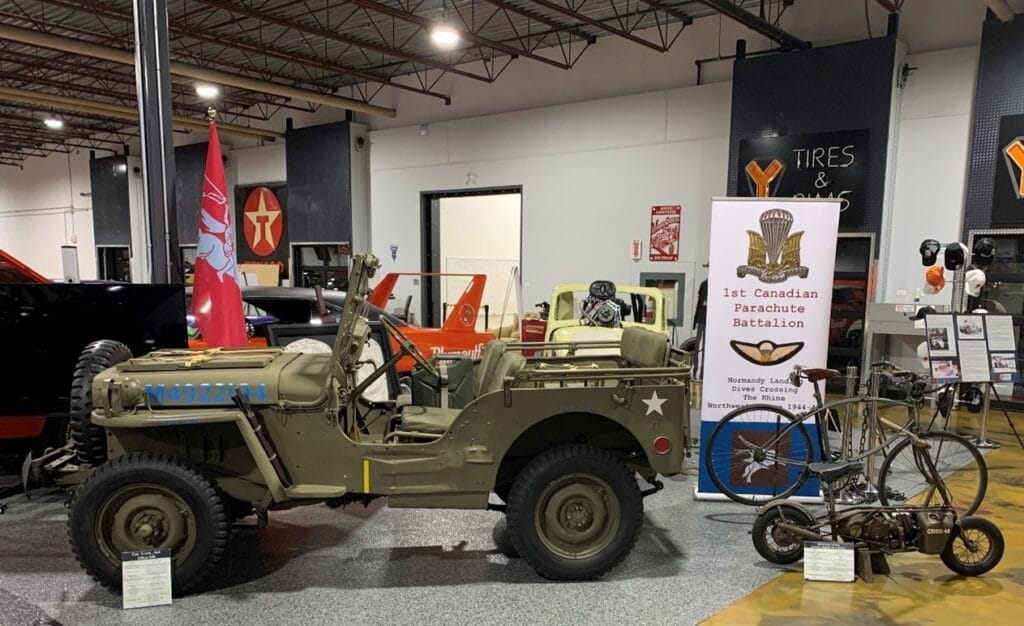
This week, the Quartermaster is back with a display of vehicles used by 1 Canadian Parachute Battalion as part of the British Airborne Forces in the North West Europe campaign of 1944-45 during the Second World War. For Remembrance Week, Yesterday’s Car Gallery invited Valour Park Association (VPA) to do a display on these iconic vehicles owned by Claude VILLENEUVE.
YESTERDAY'S AUTO GALLERY
Yesterday’s Auto Gallery is dedicated to preserving vintage vehicles for the enjoyment of present and future generations. A non-profit organization, its objective is to make these magnificent automobiles accessible to all and share the history of these incredible vehicles while showcasing them.
BRITISH AIRBORNE FORCES AND GROUND MOBILITY
What made the creation of Airborne Forces (parachute and glider borne organizations) in the Second World War so attractive was their unique capability to deploy on very short notice to drop zones (DZ) and landing zone (LZ) in almost any theatre of operation to seize or destroy strategic objectives such as airfields, bridges, or footholds. According to the War Office:
“17. In Close co-operation with large forces
In the attack, airborne troops may be used for the following roles: —
(a) To attack the enemy rear and thus assist a break-through by the main forces.
(b) To delay enemy reserves by holding defiles between them and the battlefield.
(c) To capture enemy airfields, thus assisting the gaining of air superiority.
(d) To capture enemy headquarters, thereby paralysing his system of command.
(e) Creating diversions.
(f) To delay a retreating enemy until the land troops come up.”
However, a draw back from that capability is the limited ground tactical mobility. Eventually, the unit’s “logistics tail” will reach the unit and will include some light vehicles which, when brought, are limited in number and capability. Acknowledging this shortcoming, the British doctrine for airborne operations clearly specified that:
“2. Characteristics
The characteristics of airborne troops are their: –
(a) Great strategical mobility, but comparatively small tactical mobility once landed.”
Whilst the constraint on motorized mobility was obvious the need for some ground tactical mobility remained. Recognising this need in his history of the British Airborne Forces during the Second World War, Lieutenant-Colonel T. B. H. Otway, mentioned to that effect that:
“Some form of cross-country vehicle capable of being carried in a Horsa, and if possible, of being dropped by parachute as well, had to be found to provide mobility for key personnel, signals, and weapons. The existing heavier vehicles of the Army were too big for the Horsa, and light cars of the Austin Seven type were not sufficiently powerful. The problem was solved by the lucky arrival of the American jeep, which by good fortune and with very little modification could just be squeeze into the Horsa.”
“Apart from the jeep, and until the Hamilcar Glider became available, there were no other four-wheeled airborne vehicles but large numbers of light and a proportion of heavy motor-cycles were included in the Division. An ultra-light folding motor-cycle was also developed to drop by parachute in a container.”
BRITISH FORCES AND THE JEEP
The Jeep is undeniably one of the most recognized automobiles in history and one of the most important contributions to the Allied war effort of World War II. The disastrous Battle of France cost the British army around 65,000 vehicles, either destroyed, captured, or simply abandoned following the evacuation of Dunkirk. The British Army therefore urgently needed vehicles to replace those lost. The Lend-Lease Act of 1941 authorized the U.S. government to loan or lease war supplies to any nation vital to U.S. defense without itself entering the war. The Lend-Lease Act allowed Great Britain, in great difficulty, to be able to continue fighting against Germany.
Called the “U.S. Army Truck, 1⁄4‑ton, 4×4, Command Reconnaissance”, and nicknamed “Jeep”, the War Office will designate it as “Car, 5 cwt, 4×4.” Through 29 contracts, it is estimated that 65,878 jeeps saw service with the British Forces. The exact number that saw service with the British Airborne Forces is not know.
BRITISH AIRBORNE FORCES AND THE “CAR, 5-cwt, 4X4”
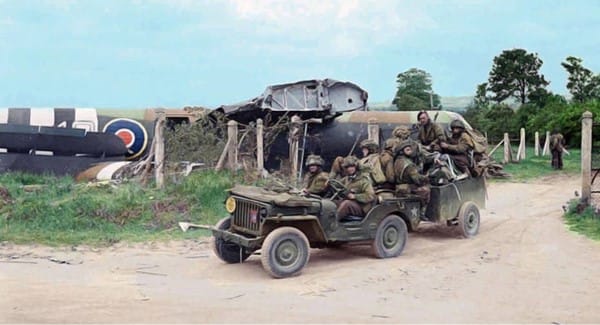
Airborne Jeeps were modified to be transported by either a Horsa Glider or a Hamilcar Glider. Official modifications were initiated by the Airborne Forces Development Centre (AFDC) based at Amesbury Abbey, Wiltshire. The following basic airborne modifications were included on all Jeeps:
- № 1 – Detachable steering wheel.
- № 1A – Repositioning of horn button.
- № 4 – Tandem towing attachment.
- № 8 – Carriage of three Jerricans (full 12 gallons).
- № 14 – Pick and shovel installed on front bumper.
- № 22 – Repositioning spare wheel carrier.
Additional potential modifications included:
- № 2 – Carriage of 2-stretchers – stretcher brackets, rear.
- № 3 – Carriage of 1-stretcher – stretcher brackets, bonnet
- № 5 – Fitting of № 22, № 62 or № 76 Wireless Set. Carriers for batteries, spares valves, remote control, and base aerial frame.
- № 7 – Installation of № 18 Wireless Set at nearside of vehicle.
- № 9 – Gun clips mounted on the driver’s side.
- № 11 – Gun angled clips mounted on dashboard
- № 12 – Repositioning of spare wheel on front bumper.
- № 15 – Carriage of ammunition carrier on bonnet.
- № 16 – Carriage of 6-pr ammunition on front bumper.
- № 18 – Carriage of ammunition carrier on front bumper.
- № 20 – Vickers K machine gun mounting on dash.
- № 21 – Towing hook
- № 23 – Installation of № 18 Wireless Set at offside of vehicle.
- № 25 – Carrier on front bumper to carry two № 5 cable drums.
- № 27 – Carriage of cable layer № 3.
- № 28 – Rear pannier carrier frame.
- № 29 – Compressor tools.
Used for a variety of purposes, the Jeep was also heavily modified when adapted for a wide variety of roles for airborne use. Variants included:
- Basic standard airborne modifications. These Jeeps were modified with standard airborne modifications to fit in a glider.
- Ambulance. In addition to standard airborne modifications, these Jeeps were modified to carry three stretchers, two in the back and one on the bonnet.
- Artillery. In addition to standard airborne modifications, these Jeeps were modified to tow either the Ordnance Quick-Firing 6-pounder 7 cwt anti tank gun, the American M1 75mm Pack Howitzer, the 20mm Polsten anti aircraft gun, or the 40mm Bofors light anti aircraft gun. These Jeeps were modified to carry additional ammunition.
- Reconnaissance. In addition to standard airborne modifications, these Jeeps were equipped with Vickers K machine gun or Bren machine gun.
- Signals. In addition to standard airborne modifications, these Jeeps were modified for varying of wireless sets used by airborne forces: № 18 (Battalion Headquarter [HQ] to Company Command Post [CP]), № 22 (Brigade HQ to Battalion HQ), №62 (Brigade HQ to Battalion HQ), or № 76 (rear link communication). These Jeeps were modified to supress radio interference, have extra batteries carriers, and some with Charging Set Lightweight 80 Watt. Some Jeeps were outfitted for laying cables for field phones.
The War Establishment (WE) Cdn III/127/2 dated 19 May 1944 for A Canadian Parachute Battalion established at seven the number of “Car, 5-cwt, 4×4”, all allocated to the Battalion HQ.
BRITISH AIRBORNE FORCES AND THE BSA BICYCLE, FOLDING, AIRBORNE PATTERN

In 1941 bicycle manufacturer BSA Cycles Ltd., a subsidiary of Birmingham Small Arms (BSA), was asked by the War Office (WO) to design a folding bicycle for the newly created British Airborne Forces. Production started mid-1942 and probably ended by 1944. No war production records have been unearthed to date. Out of the 128,000 military bicycles manufactured by BSA Cycles Ltd during the Second World War over 60,000 folding bicycles were produced. The folding bicycle was used not only by airborne troops but also by the Royal Marine Commando and some infantry units during Operation OVERLORD (the Invasion). The life required was only 50 miles but in face some achieved many thousands of miles in private hands after the war. Around the end of the Second World War surplus bicycles were available for sale. In Canada, they were sold surplus by the Hudson’s Bay Company and by Capital Iron (surplus store) for about $9.95.

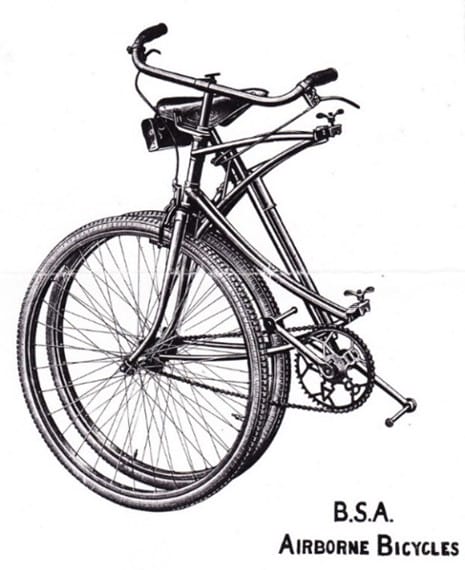
Two models were produced. The First Model (Early Twin Tube Model) had the seat post, of a smaller diameter, inserted into a tube welded to the rear of the main post. The inflator (pump) was in the front of the main post. In the Second Model, to simplify the design and streamline the manufacturing of the bicycle, the seat post was incorporated into the main post (the seat tube) adding to the robustness of the bicycle. The inflator was positioned at the rear of the main post (seat tube).
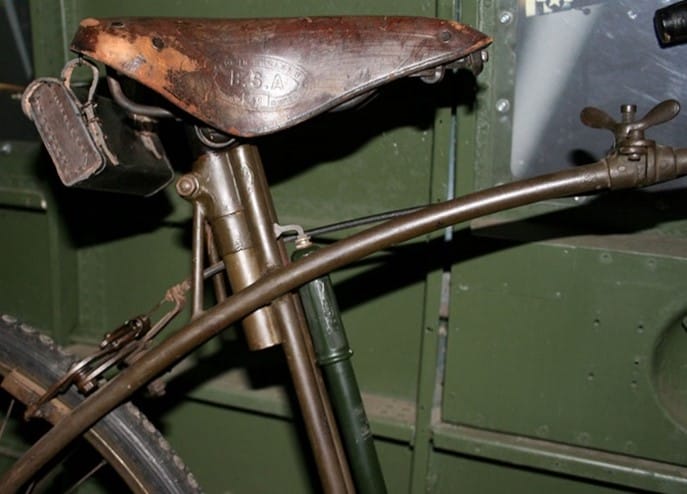
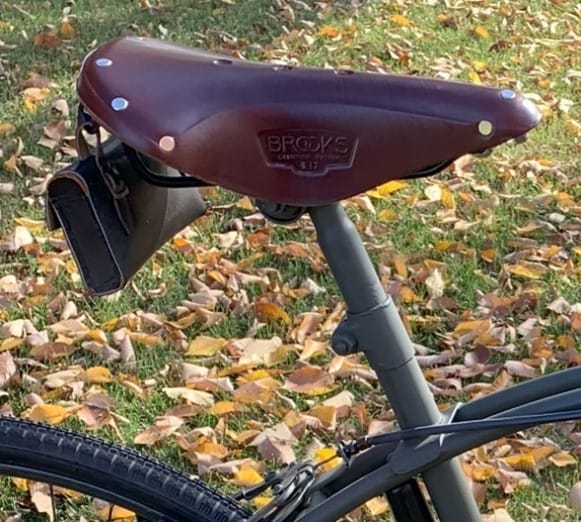
There were three ways to bring the bike onto the battlefield: either attached to a parachutist, dropped by parachute, or loaded into a glider.
The War Establishment (WE) Cdn III/127/2 dated 19 May 1944 for A Canadian Parachute Battalion established at 16 the number of Bicycles, Folding, Airborne Pattern as follows:
- Battalion Headquarters: one.
- Headquarters Company: total of 12 as follows:
- Signal Platoon: 10: and
- Mortar/Machine Gun Platoon (two platoons): one each for a total of two.
- Rifle Company Headquarters (three companies): one each for a total of three.
- Whilst in garrison, there was also 16 General Service (GS) bicycles (such as BSA Mark V) within the Administration Platoon of the Headquarters Company used for training and local transportation.
BRITISH AIRBORNE FORCES AND THE MOTORCYCLE, ULTRA-LIGHT, FOLDING, EXCELSIOR WELBIKE, MK II
The Welbike was an air droppable, ultra-light, folding, single-seat, motorcycle used by British Forces during the Second World War. The Welbike has been developed by the direction of Station IX of the Special Operations Executive (SOE), the Inter Services Research Bureau based at Welwyn, an hour north of London in Hertfordshire. Not much used by the SOE, they were issued to the British Airborne Forces and the Royal Marine Commando.
The Welbike was manufactured by Excelsior Motor Company, based in Coventry, and was powered by a Villiers Junior de Luxe 98 cc (6.0 cu in) single-cylinder 2-stroke petrol (gasoline) engine, which generated 1.5 horsepower. With full tanks totalizing 6.5 imperial pints (3.7 L / 7.8 US pint) of petroil (mixed of petrol and oil at a ratio of 16:1), the Welbike can travel 90 miles (145 km) at a speed of 30 mph (48 km/h).
Excelsior built 3,841 machines over three contracts between 1942 and 1943. The first 1,200 units were known as Mk I. The second contract was for 1,400 machines and the third contract for 1,241 machines were called Mk II. The Mk II saw the addition of a rear mudguard, a splash shielding between the tanks, and a proper filler cap on the offside tank (left) that did not require the removal of the pump on the near side (right) to fill the fuel tanks.
The Welbike was part of the airborne equipment and included in the Schedule of Equipment 5 Its purpose was described as follow:
“Lightweight folding motorcycle. Designed to increase the restricted mobility of Parachute Troops and can be dropped folded in RAF Mark I Container.”
The War Establishment (WE) Cdn III/127/2 dated 19 May 1944 for A Canadian Parachute Battalion established at 18 the number of Motorcycles, solo, 125-cc (Royal Enfield WD RE aka Flying Flea). However, if the motorcycles were not available, then Motorcycles, Folding, was to be held in lieu. Therefore, it is quite difficult to say how many Welbike were used within the British Airborne Forces during the Second World War. Distribution was as follows:
- Battalion Headquarters: four.
- Headquarters Company: total of 11 as follows:
- Mortar Platoon (two platoons); two each for a total of four.
- Anti-tank and anti-aircraft Platoon: four, and
- Administration Platoon: three.
- Rifle Companies: One per Rifle Company Headquarters for a total of three.
A Container Light Equipment (CLE) Mk I painted green and marked with white letters “Motor Cycle” was used to drop the Welbike. Before the drop, the fuel tanks were pressurized, and the handlebars and seat were folded away. The Welbike was then packed into the container with the rear wheel at the base of it, which had a percussion dome to minimise damage on landing.

Here is the list of items that were displayed.
Car, 5-cwt, 4X4 (Willys MB)
Frame № 171189
2 September 1942
War Department № M4922194
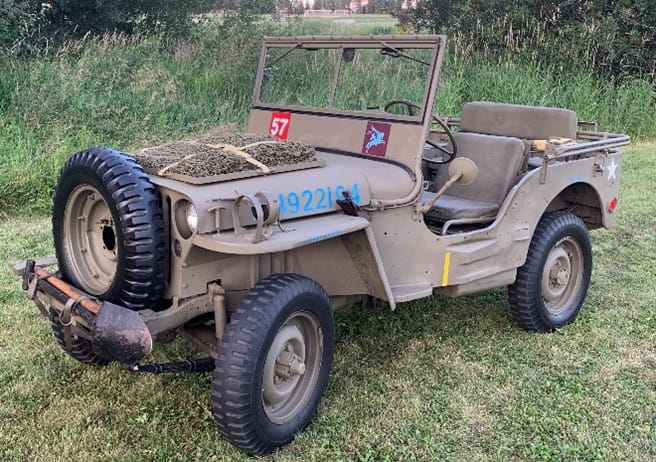



BSA Bicycle, Folding, Airborne Pattern, Second Model
Frame № 36033
Circa 1943


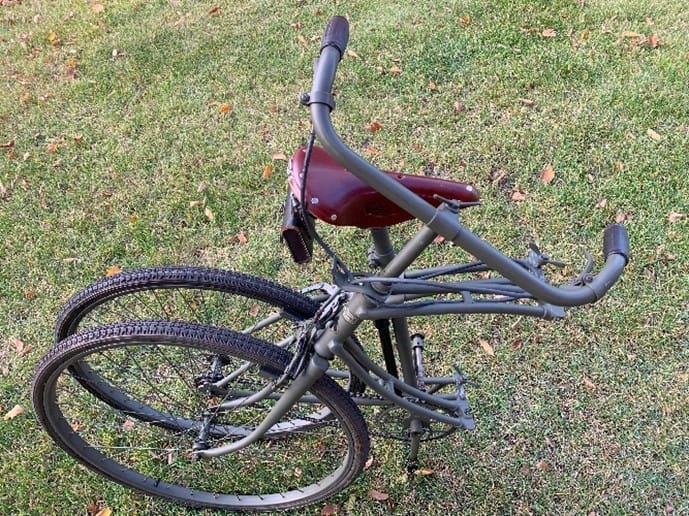

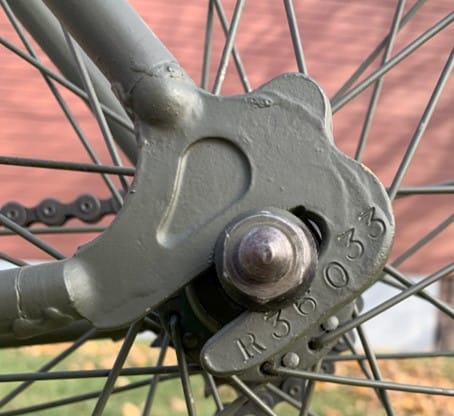
Motorcycle, Ultra-Light, Folding, Excelsior Welbike Mk II
Frame № 2348 (Second contract)
Circa 1943
War Department № C5153148

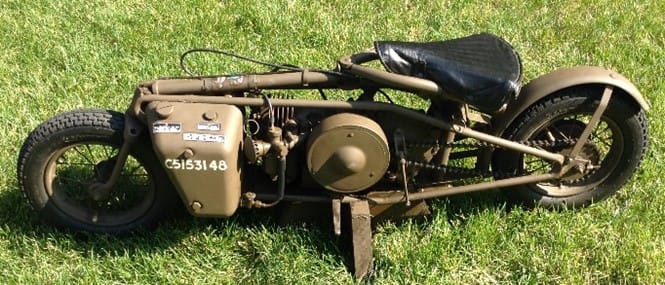
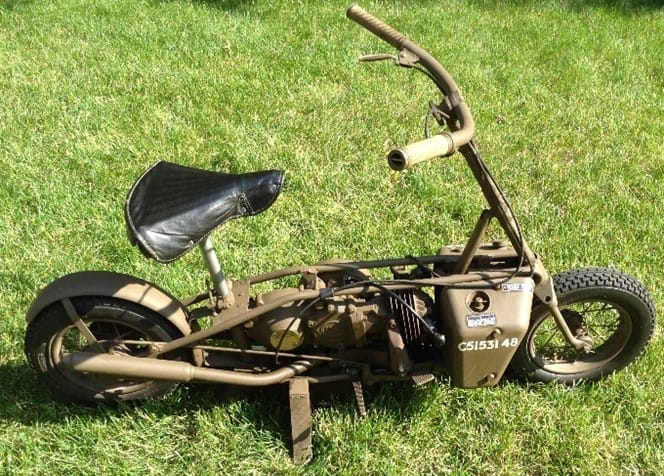

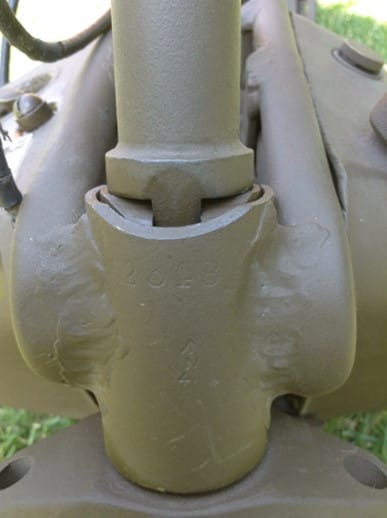


Conclusion
There will be more to see from our Quartermaster so…come to see us either at shows or our “micro” Museum! The VPA’s “micro” museum is located at SEBARMS Guns, Gear and Collectibles, 11569 – 149 Street, Edmonton, Alberta, T5M 1W9. The museum hours of operation are:
- Tuesday: from 10 to 15 hours.
- Wednesday: from 10 to 15 hours.
- Thursday: from 10 to 15 hours.
- Friday: from 10 to 15 hours.
Until next time,
The Quartermaster
REFERENCES
Primary sources
Air Ministry, Air Publication 2453A, Volume 1, Part 4, Section 2, Chapter 1, Equipment attached to the parachutist, Airborne Bicycle, May 1946
Canadian Army, War Establishment (WE) Cdn III/127/2 – A Canadian Parachute Battalion, Approved under COS 139, Effective Date 19th May 1944
War Office, 26 General Service Publication 919, Airborne Operation, Pamphlet № 1, General, May 1943
Secondary Sources
Gordon, David B., Equipment of the WWII Tommy, Revised and Expended Edition, Pictorial Histories Publishing Co., Missoula, U.S.A., 2010, 658 pages, ISBN-13: 978-1-57510-151-4
Otway, T. B. H., Lieutenant-Colonel, The Second World War, 1939-45, Army: Airborne Forces, Imperial War Museums Department of Printed Books, London, U.K., 1990, 468 pages, ISBN-10: 0-9016-2757-7
Tugwell, Maurice, Airborne to battle: a History of Airborne Warfare, 1918-1971, London, Kimber, 1971, 367 pages, ISBN-10: 0-7183-0262-1
van Meel, Rob, Excelsior Welbike, Rob van Meel Producties, Tilburg, Netherlands, 2016, 130 pages, ISBN-13: 978-90-76221-00-7
van Meel, Rob, British Airborne Jeep, 1942-1945, Modifications & Markings, Rob van Meel Producties, Tilburg, Netherlands, Tenth enlarged edition, 2013, 130 pages, ISBN-10: 90-76221-01-4
Internet
British Pathé, Factory Making Bikes And Mini Bikes (1943), https://www.youtube.com/watch?v=InudgELqCHg
Captain Stevens, BSA Airborne Bicycle, https://captainstevens.com/military/mv/bsa-airborne-bicycle/
The BSA & Military Bicycle Museum, 1942 WW2 BSA Airborne Bicycle, 1st Pattern: Early Twin Tube Model, https://bsamuseum.wordpress.com/1942-ww2-bsa-airborne-bicycle-early-twin-tube-model/
The BSA & Military Bicycle Museum, 1942-1945 WW2 BSA Airborne Bicycle, 2nd Pattern, https://bsamuseum.wordpress.com/1942-1945-bsa-airborne-bicycle-para-bike/
Visual Collector, British BSA Folding Bicycle, https://visualcollector.com/OBLI/BSABike.htm


